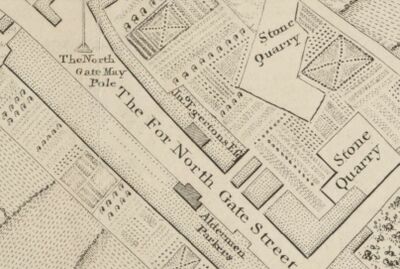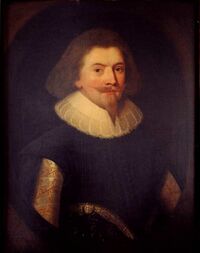Egerton
Several members of the Egerton Family feature in the history of Chester. The Egertons are an ancient Cheshire family, seated at Oulton Park near Tarporley since the Middle Ages. It is claimed that an ancestor of Roland Egerton the 1st Baronet, William le Belward (some sources say David), took the surname of Egerton from the lordship of Egerton, which he inherited. However, it is possible that he was a different branch of the family.
Thomas Egerton (1540 - 15th March 1617)
Known as Lord Ellesmere from 1603 to 1616, was an English nobleman, judge and statesman from the Egerton family who served as Lord Keeper and Lord Chancellor for twenty-one years.
Thomas Egerton was born in 1540 in the parish of Dodleston. Thomas is associated with the traditional legend of how Gallantry Bank at Bickerton got its name. He was the illegitimate son of Sir Richard Egerton of Ridley and an unmarried woman named Alice Sparks from Bickerton. Pennant records:
- "The mother had been so much neglected by Sir Richard Egerton, of Ridley, the father of the boy, that she was reduced to beg for support. A neighbouring gentleman, a friend of Sir Richard, saw her asking alms, followed by her child. He admired its beauty, and saw in it the evident features of the Knight. He immediately went to Sir Richard, and laid before him the disgrace of suffering his own offspring, illegitimate as it was, to wander from door to door. He was affected with the reproof, adopted the child, and by a proper education, laid the foundation of his future fortune."
He was thus acknowledged by his father’s family, who paid for his education. He studied Liberal Arts at Brasenose College, Oxford, and received a Bachelor’s Degree in 1559. He then studied law at Lincoln's Inn and became a barrister. He was a Roman Catholic, until a point in 1570 when his lack of conformity with the Church of England became an issue when his Inn passed on a complaint from the Privy Council. In 1579 he was elected Master of the Bench of Lincoln's Inn. On 28 June 1581 he was appointed Solicitor General. As Solicitor General, Egerton became a frequent legal advocate for the crown, often arguing cases instead of the Attorney General. Briefly, he was MP for Cheshire, 1584–87. He was one of the prosecutors at the trial of Mary, Queen of Scots, in 1586. He advised that in her indictment she should only be styled "commonly called queen of Scots," to avoid scruples about judging a sovereign. On the 8th February 1587 Mary Queen of Scots was executed at Fotheringhay Castle.
He was also the prosecutor in the trial of Philip Howard, Earl of Arundel, for high treason. He was made Attorney General on 2 June 1592, he was knighted the next year. He was made Master of the Rolls on 10 April 1594 where he excelled as an equity judge and became a patron of the young Francis Bacon. After the death of the Lord Keeper Puckering he was appointed Lord Keeper of the Great Seal and sworn a Privy Councillor on 6 May 1596, remaining Master of the Rolls and thus the sole judge in the Court of Chancery.
Egerton purchased the site of the Carmelite friary in Whitefriars in 1592-3. The friary had been dissolved in 1538 and its holdings passed in 1544 to Fulk Dutton, and a house, known as White Friars, was built on part of the site. Thereafter the friary passed in 1583 to Edmund Gamull (see:Gamul House) and in 1593 to Thomas Egerton, who in 1597 demolished the church to make way for a new building. The antiquarian Webb lamented the loss of the church (of which the steeple was used as a navigation aid until it was taken down in 1580) in the following terms:
- It was a great pitie that the steeple was put away, being a great ornament to the citie. This curious spire steeple might still have stood for grace to the citie, had not private benefit, the devourer of antiquitie, pulled it down with the church, and erected a house for more commoditie, which since hath been of little use, so that the citie lost so goodly an ornament, that tymes hereafter may more talk of it, being the only sea-mark for direction over the bar of Chester.
The site remained in the hands of Egerton's descendants until the later 18th century. Egerton built what was apparently one of the finest mansions in the city. For further information see Weaver Street. At one point Egerton appears to have owned Brewers Hall.
Egerton bought Tatton Park, in 1598 from his half sister Dorothy Brereton. It would stay in the family for more than three centuries. In 1597 or 1598 – he hired the poet John Donne as secretary. This arrangement ended in some embarrassment, since Donne secretly married Ann More, Elizabeth's niece, in 1601. Egerton was made Chamberlain of Chester in 1593. On the accession of James I, Thomas Egerton was reappointed Lord Keeper, resigning the Mastership of the Rolls in May 1603, and the Chamberlainship of Chester in August. He was a rigid churchman, hostile to both the Puritans and the Roman Catholics. He fully approved of the king's unfriendly attitude towards the former, adopted at the Hampton Court conference in 1604.
Thomas Egerton was thrice married (into the local gentry after his first wife died). By his first wife, Elizabeth, daughter of Thomas Ravenscroft of Bretton, Flintshire, he had two sons and a daughter. The elder son, Thomas, predeceased him, leaving three daughters. His third marriage on 20th October 1600 to Alice Spencer, daughter of Sir John Spencer and widow of Ferdinando, 5th Earl of Derby, was a disaster. She joined Egerton’s household with a retinue of 40 persons, estimated as being likely to add at least £650 a year to his household expenses. By 1610 Egerton, now lord chancellor and a peer, was describing his wife as extravagant, greedy and ill-tempered, with a:
- cursed railing and bitter tongue ... I thank God I never desired long life, nor never had less cause to desire it than since this, my last marriage, for before I was never acquainted with such tempests and storms.
The younger, John, succeeded his father as 2nd Viscount Brackley, was created Earl of Bridgewater, and, marrying Lady Frances Stanley (daughter of his father's third wife, widow of the 5th Earl of Derby), was the ancestor of the earls and dukes of Bridgewater, whose male line became extinct in 1829. Thomas had left everything to his son, but the widow made a determined but unsuccessful attempt to contest the will, until the son obtained probate.
John Egerton (1579 – 4th December 1649)
The son of Sir Thomas Egerton and Elizabeth Ravenscroft, he matriculated at Brasenose College, Oxford in 1589 at the age of 10, graduating as Bachelor of Arts in 1594. Egerton served as Member of Parliament (MP) for Callington from 1597 to 1598, and for Shropshire in 1601. Knighted on 8 April 1599, he was Baron of the Exchequer of Chester from 1599 to 1605.
On 27 June 1602, Egerton married Lady Frances Stanley, daughter of Ferdinando, 5th Earl of Derby and Lady Alice Spencer, Lord Bridgewater's step-mother (after Ferdinando Stanley's death, on 20 October 1600, Lady Alice had married John's father Thomas Egerton, 1st Viscount Brackley). Frances was a collector of books. Around half the contents were theological, with many works by contemporary popular devotional authors like William Perkins, Joseph Hall and Francis Rous, but she also had a wider range of literature, history, and accounts of foreign countries. The titles were almost all in English, and mostly acquired new (or not long after publication). The Egerton family library, which began to be established by Thomas Egerton, continued to be built up over succeeding generations and became known as the Bridgewater Library. It began to be dispersed in the 19th century and a significant portion of it (ca.4400 volumes) was purchased by Henry Huntington in 1917, and is now in the Huntington Library in California.
Having succeeded to his father's titles in March 1617, he was created Earl of Bridgewater on 27 May 1617.
John Milton's Comus celebrates his installation as Lord President of Wales (from 1631 to 1642). An air of controversy surrounds this masque, as the Earl of Castlehaven (1593 – 14 May 1631), Bridgewater's brother-in-law, was the subject of a sordid sodomy and rape scandal for which he was executed. Some critics have conjectured that the masque, with its focus on chastity, was designed to "cleanse" the Egerton family.
Bridgewater lived a very retired life after the civil wars broke out. He was joint-commissioner of array for Flintshire, Denbighshire, and Merionethshire in May 1643, but soon afterwards withdrew to his house at Ashridge, where he died on 4 Dec. 1649. He was buried in the neighbouring church of Little Gaddesden.
Francis Egerton (21 May 1736 – 8 March 1803)
He was the youngest son of the 1st Duke. The Bridgewater Canal from Worsley to Manchester which he constructed to transport coal obtained on his estates is usually cited as the first modern British canal as opposed to a river navigation—although the Sankey Canal is a rival to this claim, projected as a "navigation", but built as a true canal. The construction of Bridgewater's canal, with its aqueduct across the River Irwell, was carried out by James Brindley.
He did not marry, and the dukedom expired with him, although the earldom was inherited by a cousin, Lieutenant-General John Egerton.


